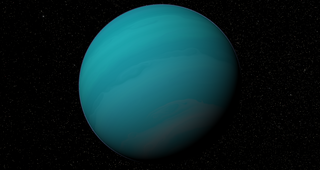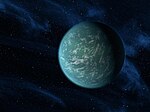Related Research Articles

Aquarius is an equatorial constellation of the zodiac, between Capricornus and Pisces. Its name is Latin for "water-carrier" or "cup-carrier", and its old astronomical symbol is (♒︎), a representation of water. Aquarius is one of the oldest of the recognized constellations along the zodiac. It was one of the 48 constellations listed by the 2nd century astronomer Ptolemy, and it remains one of the 88 modern constellations. It is found in a region often called the Sea due to its profusion of constellations with watery associations such as Cetus the whale, Pisces the fish, and Eridanus the river.

Gliese 876 is a red dwarf star 15.2 light-years away from Earth in the constellation of Aquarius. It is one of the closest known stars to the Sun confirmed to possess a planetary system with more than two planets, after GJ 1061, YZ Ceti, Tau Ceti, and Wolf 1061; as of 2018, four extrasolar planets have been found to orbit the star. The planetary system is also notable for the orbital properties of its planets. It is the only known system of orbital companions to exhibit a near-triple conjunction in the rare phenomenon of Laplace resonance. It is also the first extrasolar system around a normal star with measured coplanarity. While planets b and c are located in the system's habitable zone, they are giant planets believed to be analogous to Jupiter.

Gliese 436 is a red dwarf located 31.9 light-years away in the zodiac constellation of Leo. It has an apparent visual magnitude of 10.67, which is much too faint to be seen with the naked eye. However, it can be viewed with even a modest telescope of 2.4 in (6 cm) aperture. In 2004, the existence of an extrasolar planet, Gliese 436 b, was verified as orbiting the star. This planet was later discovered to transit its host star.

Gliese 229 is a binary system composed of a red dwarf and the first brown dwarf seen by astronomers, 18.8 light years away in the constellation Lepus. The primary component has 58% of the mass of the Sun, 69% of the Sun's radius, and a very low projected rotation velocity of 1 km/s at the stellar equator.
Gliese 581 is a red dwarf star of spectral type M3V at the center of the Gliese 581 planetary system, about 20.5 light years away from Earth in the Libra constellation. Its estimated mass is about a third of that of the Sun, and it is the 101st closest known star system to the Sun. Gliese 581 is one of the oldest, least active M dwarfs known. Its low stellar activity improves the likelihood of its planets retaining significant atmospheres, and lessens the sterilizing impact of stellar flares.

Gliese 581b or Gl 581b is an exoplanet orbiting within the Gliese 581 system. It is the first planet discovered of three confirmed in the system so far, and the second in order from the star.

Gliese 876 d is an exoplanet 15.2 light-years away in the constellation of Aquarius. The planet was the third planet discovered orbiting the red dwarf Gliese 876, and is the innermost planet in the system. It was the lowest-mass known exoplanet apart from the pulsar planets orbiting PSR B1257+12 at the time of its discovery. Due to its low mass, it can be categorized as a super-Earth.

Gliese 876 b is an exoplanet orbiting the red dwarf Gliese 876. It completes one orbit in approximately 61 days. Discovered in June 1998, Gliese 876 b was the first planet to be discovered orbiting a red dwarf.

Gliese 581d was a candidate extrasolar planet orbiting within the Gliese 581 system, approximately 20.4 light-years away in the Libra constellation. It was the third planet claimed in the system and the fourth or fifth in order from the star. Multiple subsequent studies found that the planetary signal in fact originates from stellar activity, and thus the planet does not exist.

A Super-Earth is a type of exoplanet with a mass higher than Earth's, but substantially below those of the Solar System's ice giants, Uranus and Neptune, which are 14.5 and 17 times Earth's, respectively. The term "super-Earth" refers only to the mass of the planet, and so does not imply anything about the surface conditions or habitability. The alternative term "gas dwarfs" may be more accurate for those at the higher end of the mass scale, although "mini-Neptunes" is a more common term.
Gliese 849, or GJ 849, is a small, solitary star in the equatorial constellation of Aquarius. It has a reddish hue and is invisible to the naked eye with an apparent visual magnitude of 10.41. The distance to this star is 28.8 light-years based on parallax, but it is drifting closer to the Sun with a radial velocity of −15.3 km/s. It has a pair of confirmed gas giant companions.

Gliese 581e or Gl 581e is an exoplanet orbiting within the Gliese 581 system, located approximately 20.4 light-years away from Earth in the Libra constellation. It is the third planet discovered in the system and the first in order from the star.

An exoplanet is a planet located outside the Solar System. The first evidence of an exoplanet was noted as early as 1917, but was not recognized as such until 2016; no planet discovery has yet come from that evidence. What turned out to be the first detection of an exoplanet was published among a list of possible candidates in 1988, though not confirmed until 2003. The first confirmed detection came in 1992, with the discovery of terrestrial-mass planets orbiting the pulsar PSR B1257+12. The first confirmation of an exoplanet orbiting a main-sequence star was made in 1995, when a giant planet was found in a four-day orbit around the nearby star 51 Pegasi. Some exoplanets have been imaged directly by telescopes, but the vast majority have been detected through indirect methods, such as the transit method and the radial-velocity method. As of 1 December 2023, there are 5,550 confirmed exoplanets in 4,089 planetary systems, with 887 systems having more than one planet. This is a list of the most notable discoveries.
GJ 3634 is a red dwarf star in the Hydra constellation. One planet has been discovered in its orbit, GJ 3634 b. GJ 3634 is under half the mass and size of the Sun, and is estimated to be at least a billion years younger, and lies near to Earth, with a distance of 66.5 light-years. It was targeted by astronomers during an over six-year survey of red dwarfs. The astronomers had recently changed their strategy to search for planets with extremely short orbits so they could narrow down candidates that transited, or crossed in front of, their host stars as seen from the Earth. The super-Earth GJ 3634 b was the first planet discovered using this new strategy. The planet was confirmed using Doppler spectroscopy, or the observation and extrapolation of data from a recorded Doppler effect in the star's light, but later observations found no transiting pattern. The planet was published by its discoverers on February 8, 2011.
Gliese 15 Ab, also commonly called Groombridge 34 Ab, rarely called GX Andromedae b is an extrasolar planet approximately 11 light-years away in the constellation of Andromeda. It is found in the night sky orbiting the star Gliese 15 A, which is at right ascension 00h 18m 22.89s and declination +44° 01′ 22.6″.
Gliese 536 b also known as GJ 536 b is a nearby Super-Earth sized exoplanet orbiting interior to the circumstellar habitable zone of the red dwarf (M1) star Gliese 536 every 8.7 days. Due to its short orbital period it could help with future studies of biological activity on exoplanets.
Luyten b is a confirmed exoplanet, likely rocky, orbiting within the habitable zone of the nearby red dwarf Luyten's Star. It is the fourth-closest potentially habitable exoplanet known, at a distance of 12 light-years. Only Proxima Centauri b, Ross 128 b, and GJ 1061 d are closer. Discovered alongside Gliese 273c in June 2017, Luyten b is a super-Earth of around 2.89 times the mass of Earth and receives only 6% more starlight than Earth, making it one of the best candidates for habitability.
GJ 3470 is a red dwarf star located in the constellation of Cancer, 96 light-years away from Earth. With a faint apparent magnitude of 12.3, it is not visible to the naked eye. It hosts one known exoplanet.
References
- 1 2 3 4 5 6 7 8 9 10 11 Bonfils, Xavier; Gillon, Michael (2011). "A short-period super-Earth orbiting the M2.5 dwarf GJ 3634: Detection with Harps velocimetry and transit search with Spitzer photometry". Astronomy and Astrophysics . European Southern Observatory. 528. arXiv: 1102.1420 . Bibcode:2011yCat..35280111B. doi:10.1051/0004-6361/201015981. S2CID 204933219. Archived from the original on 2021-11-05. Retrieved 2021-11-05.
- ↑ Jean Schneider (2011). "Interactive Extra-solar Planets Catalogue (Candidates detected by radial velocity or astrometry)". Extrasolar Planets Encyclopaedia . Archived from the original on 28 July 2012. Retrieved 30 April 2011.
- 1 2 3 4 5 6 7 8 Jean Schneider (2011). "Notes for star GJ 3634". Extrasolar Planets Encyclopaedia . Archived from the original on 29 July 2012. Retrieved 8 April 2011.
- ↑ "Archived copy". Archived from the original on 2016-10-07. Retrieved 2021-11-05.
{{cite web}}: CS1 maint: archived copy as title (link) - ↑ Riedel, A. R.; Subasavage, J. P.; Finch, C. T.; Jao, W. C.; Henry, T. J.; Winters, J. G.; Brown, M. A.; Ianna, P. A.; Costa, E.; Mendez, R. A. (2010). "The Solar Neighborhood. XXII. Parallax Results from the CTIOPI 0.9 m Program: Trigonometric Parallaxes of 64 Nearby Systems with 0.′′5 ≤ μ ≤ 1.′′0 yr−1 (SLOWMO Sample)". The Astronomical Journal . 140 (3): 897–911. arXiv: 1008.0648 . Bibcode:2010AJ....140..897R. doi:10.1088/0004-6256/140/3/897. S2CID 119183935.
- ↑ David Williams (17 November 2010). "Mercury Fact Sheet". Goddard Space Flight Center . NASA. Archived from the original on 18 January 2017. Retrieved 30 April 2011.


